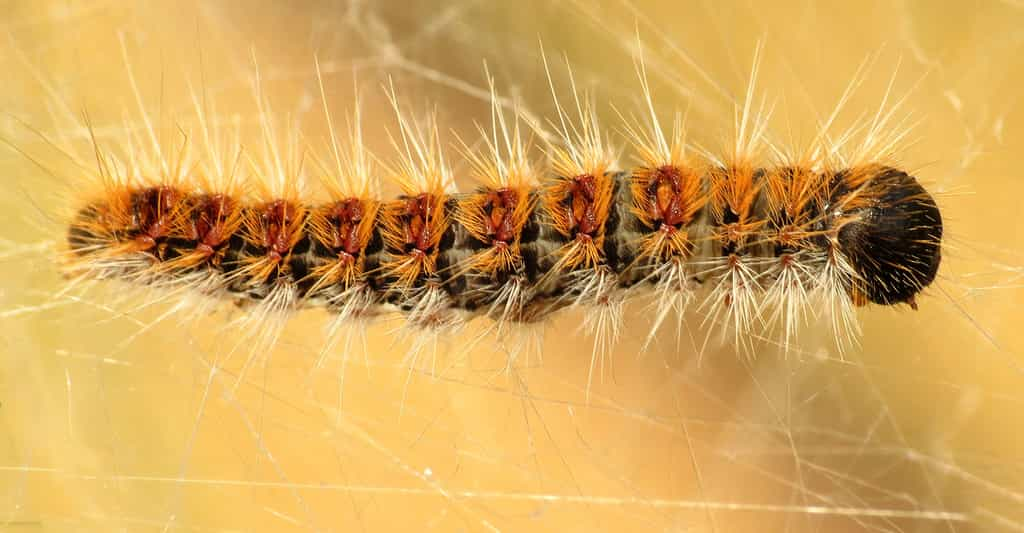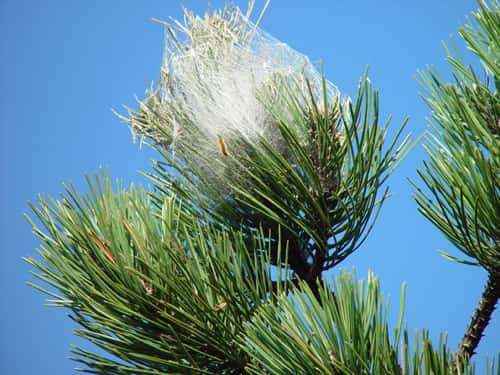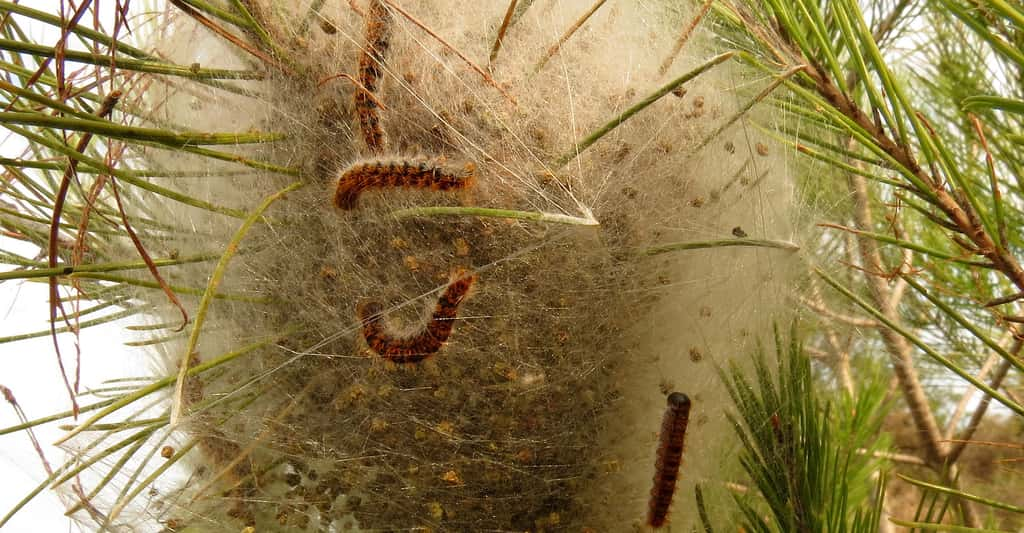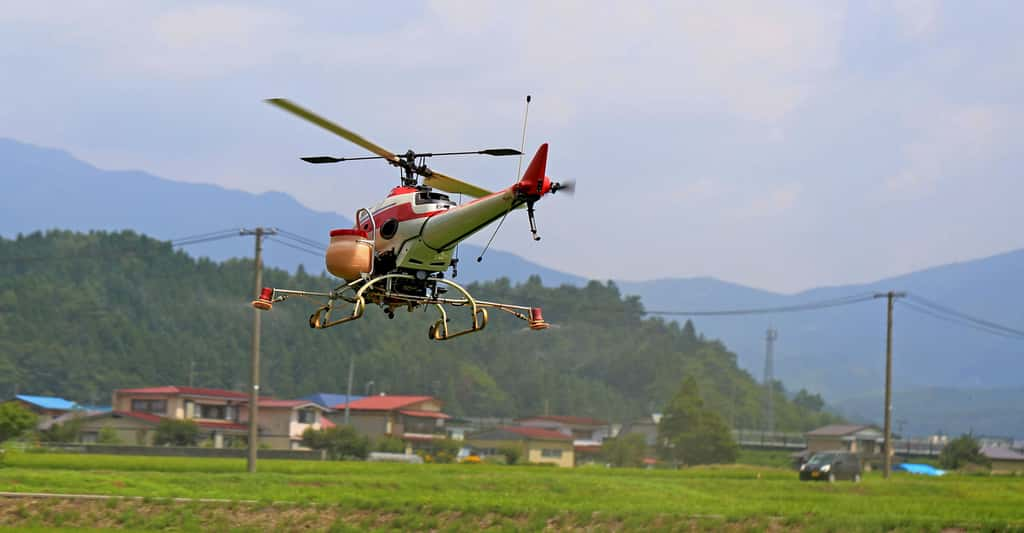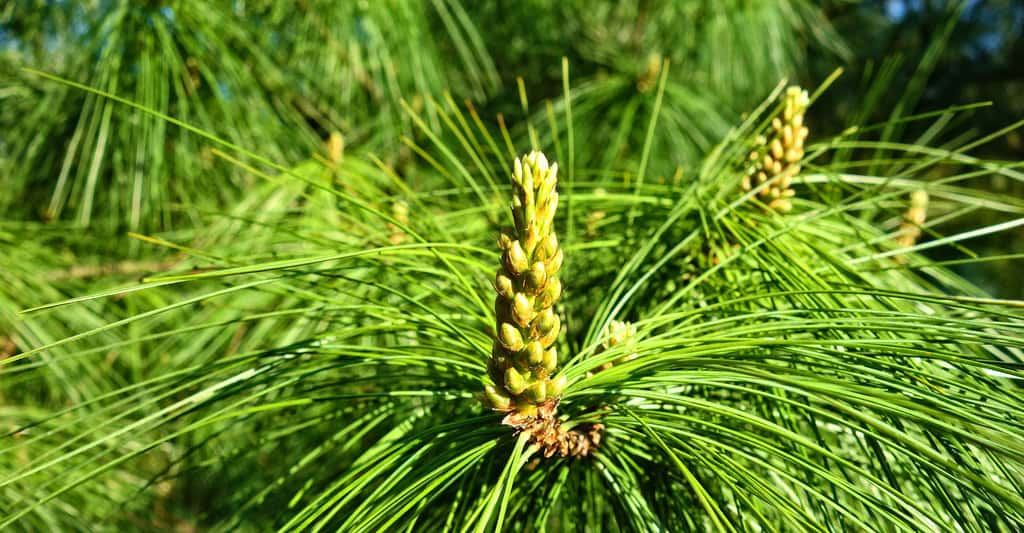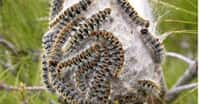au sommaire
Pour en savoir plus sur la chenille processionnairechenille processionnaire du pin, voici une bibliographie.

Gros plan sur la chenille processionnaire du pin (Thaumetopoea pityocampa). © Katja Schulz, Wikimedia Commons, CC by 2.0
- ARDITTI J., DAVID J.M., JEAN P. & JOUGLARD J. 1988. AccidentsAccidents provoqués par la chenille processionnaire du pin en Provence. J. Tox. Clin. Exp. 8(4) : 247 251 ;
- ARONSON A.I., GENG C., and WU L., 1999. Aggregation of Bacillus thuringiensisBacillus thuringiensis Cry1A toxins upon binding to target insect larval midgut vesicles. Appl. Env. Microbiol. 65(6) : 2503-2507 ;
- BURJERON A. 1972. Étude des facteurs responsables du rythme nycthéméral de la prise alimentaire des chenilles de Thaumetopoea pityocampa Schiff. et des conséquences sur la virose cytoplasmique. Ann. Zool. - Écol. Anim. 4(3) : 353-366 ;
- DAJOZ R. 1998. Les insectesinsectes et la forêt. Éd. Lavoisier Tec&Doc, 594 p., Paris ;
- DÉMOLIN G., 1967b. GrégarismeGrégarisme et subsocialité chez Thaumetopoea pityocampa Schiff. Nid d'hiverhiver - activité de tissage. C. R. Ve congrès de l'union internationale pour l'étude des insectes sociaux. pp 69-77 ;
- DÉMOLIN G., 1969a. Comportement des adultes de Thaumetopoea pityocampa Schiff. Dispersion spatiale, importance écologique. Ann. Sci. Forest. 26(1) : 81 102 ;
- DÉMOLIN G., 1969b. Bioecologica de la processionnaria deldel pino, Thaumetopoea pityocampa. Incidencia de los factores climaticos. Bol. Serv. Plagas Forest. 23 : 9-24 ;
- DÉMOLIN G., 1969c. La processionnaire du pin. Note d'information sur la biologie et sur les techniques de lutte ;
- DÉMOLIN G., 1971. IncidencesIncidences de quelques facteurs agissant sur le comportement social des chenilles de Thaumetopoea pityocampa Schiff. (Lepidoptera)) pendant la période des processions de nymphosenymphose - Répercussions sur l'efficacité des parasitesparasites. Ann. Zool. - Écol. Anim. Hors série : 33-56 ;
- DÉMOLIN G., MARTIN J.C., LAVANCEAU P., 1993. Lutte contre la processionnaire du pin - L'évolution des insecticidesinsecticides à base de Bacillus thuringiensis. Phytoma. 452 : 13-16 ;
- DEMOLIN G., MARTIN J.C, 1998. Lutte contre la processionnaire du pin. Efficacité et persistance d'action de deux formulations à base de Bacillus Thuringiensis. Phytoma. 507 : 11-14 ;
- DUCOMBS G., LAMY M., BERGAUD J.J., TAMISIER J.M., GERVAIS C. et TEXIER L. 1979. La chenille processionnaire (Thaumetopoea pityocampa Schiff. LépidoptèresLépidoptères) et l'Homme - Étude morphologique de l'appareil urticant. Enquête épidémiologique. Ann. Dermatol. Venereol. 106 : 769-778 ;
- DULMAGE H.TT. et AIZAWA K., 1982. Distribution of Bacillus thuringiensis in nature. In : Microvial and viral pesticidespesticides. Éd. E Kurstak. pp 209-237. New York ;
- GLARE T.R. et O'CALLAGHAN M., 2000. Bacillus thuringiensis : Biology, Ecology and Safety. Éd. Wiley. Chichester. 350 p. ;
- GROCHULSKI P., MASSON L., BORISOVA S., PUSZTAI-CAREY M., SCHWARTZ J.L., BROUSSEAU R. et CYGLER M., 1995. Bacillus thuringiensis CryIA(a) insecticidal toxin : crystal structure and channel formation. J. Mol. Biol. 254 : 447-464 ;
- GUERRERO A., CAMPS F., COLL J. et RIBA M. 1981. Identification of a potential sex pheromone of the processionary moth, Thaumetopoea pityocampa (Lepidoptera, Notodontidae). Tetrahedron Lett. 22(21) : 2013-2016 ;
- JOUNG K.B. et CÔTÉ J.C., 2000. Une analyse des incidences environnementales de l'insecticide microbien Bacillus thuringiensis. Bull. technique n° 29 ;
- LEONG K.L.H.L.H., CANO R.J., et KUBINSKI A.M., 1980. Factors affecting Bacillus thuringiensis total fiel persistence. Env. Entomol. 9 : 593-599 ;
LIU Y.B., TABASHNIK B.E., MOAR W.J. et SMITH R.A., 1998. Synergism between Bacillus thuringiensis spores and toxins against resistant and susceptible diamondback moths (Plutella xylostella). Appl. Env. Microbiol. 64(4) : 1385-1389 ; - MARKALAS S. 1989. Influence of soil moisture on the mortality, fecundity and diapause of the pine processionary moth (Thaumetopoea pityocampa Schiff.). J. Appl. Ent. 107 : 211- 215 ;
- MARTIN J.C. et MAZET R., 2001. Lutte hivernale contre la processionnaire du pin. Possibilité d'utilisation du Bacillus thuringiensis K. Phytoma. 540 : 32-35 ;
- MARTIN J.C., MAZET R., JEAN F. et BONNEAU X. 2003. Essais comparatifs du Foray 96B, du Foray 76SI et du Foray 48SI contre la processionnaire du pin au cours de l'automneautomne 2002. Rapport de fin de prestation pour la société Valent BioSciences ;
- MARTIN J.C., MAZET R., JEAN F. et BRUNETTO W. 2004. Essais d'efficacité du Foray 76SI et du Foray 48SI contre la processionnaire du pin - automne 2004. Rapport de fin de prestation pour la société Valent BioSciences ;
- MARTIN J.C., LECOCQ J., MAZET R., JEAN F., GILG O. et REI F. 2006. Comparaison de l'efficacité de trois insecticides microbiologiques à base de BtK en traitement aérien contre les chenilles du Bombyx disparate : le Foray 96B à 2L/ha, le Foray 76B à 2,5L/ha et le VBC 60074 à 0,7 kgkg/ha. Rapport de fin de prestation pour la société Valent BioSciences ;
- MYASNIK M., MANASHEROB R., BEN-DOV E., ZARITSKY Y. et BARAK Z., 2001. Comparative sensitivity to UVUV-B radiation of two Bacillus thuringiensis subspecies and other Bacillus sp. Curr. Microbiol. 43 : 140-143 ;
- NESTER E.W., THOMASHOW L.S., METZ M. et GORDON M., 2002. 100 years of Bacillus thuringiensis : a critical scientific assessment. Report from the American Academy of Microbiology. (Disponible ici) ;
- SOPUCK L., OVASKA K., and WHITTINGTON B., 2002. Responses of songbirds to aerial spraying of the microbial insecticide Bacillus thuringiensis var. kurstaki (Foray 48B®) on Vancouver Island, British ColumbiaColumbia, Canada. Env. Tox. Chem. 21(8) : 1664-1672 ;
- THEUNIS W., AGUDA R.M., CRUZ W.T., DECOCK C., PEFEROEN M., LAMBERT B., BOTTRELL D.G., GOULD F.L., LITSINGER J.A. et COHEN M.B., 1998. Bacillus thuringiensis isolates from the Philippines : habitat distribution, δ-endotoxin diversity, and toxicity to rice stem borers (Lepidoptera : Pyralidae). Bull. Ent. Res. 88 : 335-342 ;
- TIBÉRI R., NICCOLI A., CURINI M., EPIFANO F., MARCOTULLIO M.C. & ROSATI O. 1999. The role of monoterpene composition in Pinus ssp. needles, in host selection by the pine processionary caterpillar, Thaumetopoea pityocampa. Phytoparasitica. 27(4) : 263-272 ;
- TOJO A. et AIZAWA K., 1983. Dissolution and degradation of Bacillus thuringiensis deltadelta-endotoxin by gut juicejuice protease of the silkworm Bombyx moriBombyx mori. Appl. Env. Microbiol. 45 : 576-580 ;
WILSON G.R. et BENOIT T.G., 1993. Alkaline pH activates Bacillus thuringiensis spores. J. Invert. Pathol. 62 : 87-89. - WERNO J. et LAMY M. 1990. Pollution atmosphérique d'origine animale : les poils urticants de le chenille processionnaire du pin (Thaumetopoea pityocampa Schiff.) (Insectes, Lépidoptères). C. R. Acad. Sci. de la vie. 310(8) : 325-331 ;
- WERNO J., LESTHELLE S., DOERMAN F. et VINCENDEAU P. 2002. Envenimations par les lépidoptères. Rev. Fr. Lab. 342 : 35-39 ;
- ZAMOUN M., DEMOLIN G. et MARTIN J.C. 2005. Lutte contre la processionnaire du pin : que deviennent les chenilles survivantes après un traitement au Bt aux stades L3 et L4. Phytoma - la défense des végétaux 585 : 38-41.
